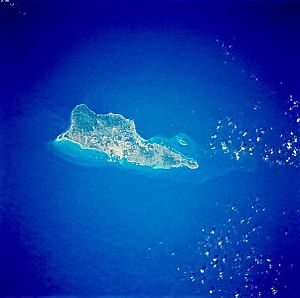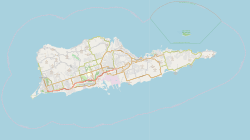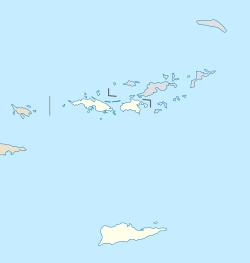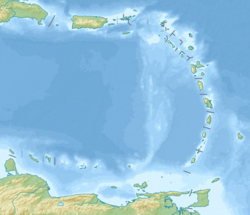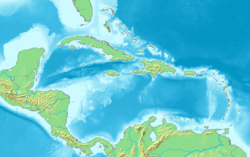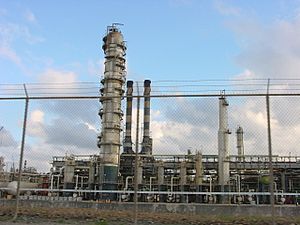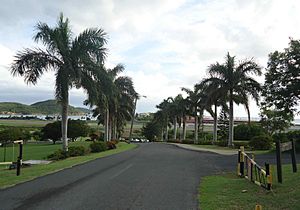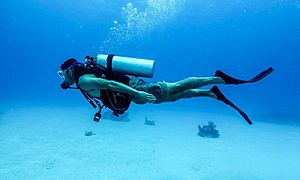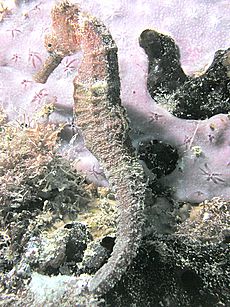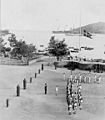Saint Croix facts for kids
|
Nickname: Twin City
|
|
|---|---|
|
Saint Croix from space, January 1992
|
|
| Geography | |
| Location | Caribbean Sea |
| Coordinates | 17°44′23″N 64°44′20″W / 17.73972°N 64.73889°W |
| Archipelago | Virgin Islands, Leeward Islands |
| Area | 82 sq mi (210 km2) |
| Length | 22 mi (35 km) |
| Width | 7 mi (11 km) |
| Highest elevation | 1,165 ft (355.1 m) |
| Highest point | Mount Eagle |
| Administration | |
| Territory | Virgin Islands |
| District | District of Saint Croix |
| Demographics | |
| Demonym | Crucian |
| Population | 50,601 (2010) |
| Pop. density | 610 /sq mi (236 /km2) |
Saint Croix is an island in the Caribbean Sea, and a county and constituent district of the United States Virgin Islands (USVI), an unincorporated territory of the United States.
St. Croix is the largest of the islands in the territory, being 28 by 7 miles (45 by 11 km). However, the territory's capital, Charlotte Amalie, is located on Saint Thomas.
Contents
History
The island was inhabited by various indigenous groups during prehistory. Christopher Columbus landed forces on the island on November 14, 1493, and was attacked by the Kalinago, who lived at Salt River on the north shore. Control of the island was traded among various powers, including Spain, the Netherlands, the Knights of Malta, and Great Britain before it became a possession of France from 1650 until 1733. On June 13, 1733, France sold the island group to the Danish West India Company. For nearly 200 years, St. Croix, St. Thomas and St. John were known as the Danish West Indies; around the mid to late 18th century, "at the peak of the plantation economy, the enslaved population of St. Croix numbered between 18,000 and 20,000, the white population ranging between 1,500 and 2,000".
In 1916, Denmark sold St. Croix, St. Thomas, and St. John to the United States, formalizing the transfer in the Treaty of the Danish West Indies, in exchange for a sum of US$25 million in gold. In a national referendum on the issue, 64.2% of Danish voters approved the sale. An unofficial referendum held in the islands resulted in 99.83% vote in favor of the purchase. The island's inhabitants were granted United States citizenship in 1927. Industrialization of the island and its move away from an agrarian society took place in the 1960s. The 2012 shutdown of the Hovensa refinery resulted in the loss of many jobs, so that some people have returned to subsistence agriculture.
Geography
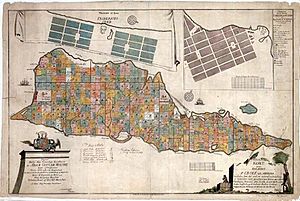
St. Croix lies at 17°45′N 64°45′W / 17.750°N 64.750°W: the easternmost point in the United States of America is St. Croix's Point Udall. The island has an area of 214.66 km² (82.88 sq mi). The terrain is rugged, though not extremely so. The highest point on the island, Mount Eagle, is 1,165 feet (355 m) high. Most of the east end is quite hilly and steep, as is the north side from Christiansted west. From the north side hills, a fairly even plain slopes down to the south coast: this was cultivated as the prime sugar land on the island.
Climate
The trade wind blows more or less along the length of the island. The hills of the western part of the island receive a good deal more rain than the east end; annual rainfall is on the whole extremely variable, averaging perhaps forty inches (1,000 mm) a year. The east end of the island is a dry desert range with a substantial amount of cactus, while the west end has lush vegetation and palm trees. The island has multiple ecosystems in a small geographic area. Fairly severe and extended drought has always been a problem, particularly considering the lack of fresh ground water and lack of freshwater streams or rivers on the island. The island has a desalination plant, but most residential homes and businesses have built-in cisterns used to collect rainwater.
Demographics
Inhabitants are called Crucians (frequently written as "Cruzans.")
There is much debate as to what constitutes a native Crucian. The consensus in Crucian society is that if one is bahn ya ("born here" in Crucian dialect) on St. Croix, they can claim to be Crucian. Because of heavy migration from other islands in the Lesser Antilles and Puerto Rico throughout the 20th century, most native-born Crucians are descended from enslaved Africans whose descendants moved from other Caribbean islands. Those considered the ancestral natives of St. Croix are descendants of African slaves brought to the island by the Danish during the 18th and 19th centuries, and laborers recruited by the Danish after emancipation in 1848.
Puerto Rican migration was prevalent in the 1930s, 40s and 50s, when many Puerto Ricans relocated to St. Croix for work after the collapse of the sugar industry. In addition, the U.S. Navy purchase of two-thirds of the nearby Puerto Rican island of Vieques during World War II resulted in the displacement of thousands of Puerto Ricans, many of whom relocated to St. Croix because of its similar size and geography. The local holiday, Puerto Rico/U.S. Virgin Islands Friendship Day, has been celebrated since the 1960s on October 10, (the same date as Columbus Day). Puerto Ricans in St. Croix, most of whom have lived here for more than a generation, have kept their culture alive while integrating into the mainstream Crucian culture as well. For example, in informal situations, many Puerto Ricans in St. Croix speak a unique Spanglish-like combination of Puerto Rican Spanish and the local Crucian creole dialect.
Migration from "down-island" (a Virgin Islander colloquial term for Caribbean islands east and south of the U.S. and British Virgin Islands), occurred mainly throughout the 1960s and 70s. In that period, agriculture declined as the major industry on St. Croix, to be replaced by tourism, alumina production, and oil refining. Jobs were plentiful in these industries and down-islanders came to St. Croix by the thousands. Many down-islanders made St. Croix their permanent home, while others eventually returned to their native islands. Most down-islanders came from St. Kitts & Nevis, Antigua, St. Lucia and Dominica, although people from every Anglophone Caribbean island can be found on St. Croix.
Continental Americans, although small in number in comparison to Caribbean immigrants, have also been part of the St. Croix community. Most reside on the East End of St. Croix. Arab Palestinians have been an influential part of the local economy since the 1960s, when they first started to migrate to St. Croix to set up shops, supermarkets and gas stations. In the 21st century, recent waves of migration to St. Croix include people from the Dominican Republic, Haiti, Jamaica, the Philippines, and various South American nations.
St. Croix's history of migration has sometimes caused tensions between immigrants and Crucians whose ancestry on the island dates back for generations. Tensions have subsided to some extent in recent years, mainly due to intermarriage among Crucians and other Caribbean peoples. In the late 1990s, many people supported legislation to define as a "native U.S. Virgin Islander" anyone who could trace their ancestry on the island to 1927, the year in which U.S. Virgin Islanders were granted United States citizenship. This effort by a select group of nationalist senators eventually failed after much public outcry and controversy. It was learned that most native-born U.S. Virgin Islanders would not qualify as "native" under the proposed legislation, as their immigrant ancestors had arrived later than 1927, but thousands of Danish citizens would have qualified.
In 2009, the proposed U.S. Virgin Islands Constitution voted by the Fifth Constitutional Convention established three definitions of U.S. Virgin Islanders: "Ancestral Native Virgin Islander" - those with ancestral ties (and their descendants); "Native Virgin Islander" - those born on the island (and their descendants); and "Virgin Islander" - any United States citizen who has resided in the territory for five years. The proposed constitution was rejected by the United States Congress in 2010 for violating the principle of equal rights for all citizens of the territory, "native" or not, and was sent back to the convention for further consideration.
The total population of the island as per the 2010 U.S. Census is 50,601.
St. Croix is divided into the following subdistricts (with population as per the 2010 U.S. Census):
- Anna's Hope Village (pop. 4,041)
- Christiansted (pop. 2,626)
- East End (pop. 2,453)
- Frederiksted (pop. 3,091)
- Northcentral (pop. 4,977)
- Northwest (pop. 4,863)
- Sion Farm (pop. 13,003)
- Southcentral (pop. 8,049)
- Southwest (pop. 7,498)
Language
English is the most common language. Danish was once the official language of the island during its days as a Danish colony, but was never widely spoken. Spanish is spoken by Puerto Rican and Dominican (Dominican Republic) immigrants and their St. Croix-born offspring, and various French creoles are spoken by the large St. Lucian and Dominican (Dominica) communities, as well as the smaller Haitian one. A native English-based creole known on the island as Crucian is also spoken by the majority of the population in informal situations. Arabic is common among the large Palestinian community on St. Croix.
Religion
Christianity is the predominant religion; the island has been called the "Land of Churches" for the approximately 150 churches that serve its 50,000 residents.
Protestant denominations are the most prevalent, but there is also a significant Roman Catholic presence due to St. Croix's large Hispanic population, as well as Irish influence during the Danish colonial period. Anglican, Methodist, Moravian, Presbyterian, Pentecostal and Seventh-day Adventists are among the Protestant denominations prevalent on the island. There are also followers of the Jehovah's Witness tradition, as well as The Church of Jesus Christ of Latter-Day Saints (LDS or Mormon).
As in most of the Caribbean, various forms of Rastafari are practiced on the island. Islam is prevalent among the small local Arab population, and there is a small Jewish presence as well.
Economy
St. Croix was once an agricultural powerhouse in the Caribbean, but this period ended with the rapid industrialization of the island's economy in the 1960s. Like many other Caribbean islands today, St. Croix has tourism as one of its main sources of revenue. A number of other industries on the island contribute to the economy.
St. Croix was home to HOVENSA, one of the world's largest oil refineries. HOVENSA is a limited liability company owned and operated by Hess Oil Virgin Islands Corp. (HOVIC), a division of U.S.-based Hess Corporation, and Petroleos de Venezuela, SA (PDVSA), the national oil company of Venezuela. Gas prices on the island were slightly higher than average when compared to gas prices in the continental United States.
On January 18, 2012, the company announced that the HOVENSA refinery would be permanently shut down. This was expected to have a major adverse effect on the economy of St. Croix and the entire U.S. Virgin Islands, as the refinery employed 1,200 residents and 950 contractors.
St. Croix is also home to the Cruzan Rum Distillery, makers of Cruzan Rum, a brand of Beam Global. The Cruzan Rum Distillery was founded in 1760 as Estate Diamond, and for many years used locally grown sugar cane to produce a single "dark" style rum. The distillery now imports sugar cane molasses from other countries in the region, primarily from the Dominican Republic and South America. In recent years, Cruzan Rum, along with Bacardi from Puerto Rico and Gosling's from Bermuda, has contributed to the resurgence of "single barrel," super-premium rum. The quality and smoothness of the Cruzan Estate Rums has won more than 30 Spirit Awards. Cruzan Estate Diamond Rum (aged 5 years in American oak barrels) and Cruzan Single Barrel Estate Rum (aged 12 years in American oak barrels) are just a couple of examples.
Diageo has completed construction of a new distillery on a 26-acre industrial site next to the Hovensa Refinery. The new distillery produces Captain Morgan Rum. Diageo's entrance into the U.S. Virgin Islands rum industry has been controversial. The cash-strapped U.S. Virgin Islands government secured $250 million in bonds for the plant, about which the Puerto Rican government has bitterly complained.
Transportation
Island roads tend to be poorly surfaced and may take sharp turns due to the terrain. Cars drive on the left hand side of the road, but nearly all the automobiles on the island have left side steering columns. This has proven difficult for new residents and visitors from right-hand traffic locales such as the mainland United States and Puerto Rico.
There is a public bus service called Virgin Islands Transit, also known as VITRAN, operated by the Virgin Islands Department of Public Works.
In addition to taxis and buses, St. Croix has shared taxis, locally known as "taxi buses" (also found on the other U.S. Virgin Islands). Taxi buses are full-sized vans running a route from Frederiksted to Christiansted. Taxi buses are privately owned and operated; they do not follow a regular schedule, and there are no pre-specified stops. People simply wait by the side of the road until a taxi bus approaches, then flag the driver down by waving. Passengers can get out anywhere along the taxi route. Taxis are not metered and are required by law to charge a flat rate of $2.50, regardless of where a rider gets on and off. Taxis to specific locations are much more expensive and are typically used by tourists.
The Henry E. Rohlsen International Airport services St. Croix with regular flights from the U.S. mainland, Puerto Rico, and the Eastern Caribbean. Seaplanes, operated by Seaborne Airlines, also serve the island, taking off and landing in Christiansted Harbor. Ferry service to St. Thomas operates from Gallows Bay, although it has been suspended indefinitely since July 2011. Although St. Croix is a U.S. territory, the U.S. Virgin Islands are maintained as a free port in a separate customs zone. Therefore, travelers to and from the continental United States and Puerto Rico must clear U.S. customs but do not need to present a passport, and only need proof of U.S. citizenship or nationality. The immigration status of non-U.S. citizens may be verified during this process.
Education
The St. Croix School District operates public schools in St. Croix. There also exist multiple private schools, including, but not limited to, St. Croix Montessori, Star Apple Montessori School, The Good Hope Country Day School, AZ Academy, St. Mary's Catholic School, Free Will Baptist, and The Manor School. The only colleges on island are the University of the Virgin Islands, St. Croix campus and Barry University also operates a small campus on the island training physician assistants.
Culture
Festivals
The island's largest festival, termed "Crucian Christmas Carnival," is celebrated on St. Croix throughout late December and early January. Another significant festival is the Agricultural and Food Fair held in mid-February.
Several times a year, there is a nighttime festival in Christiansted called "Jump-Up" and a monthly event called "Sunset Jazz" in Frederiksted, where local jazz musicians play on Frederiksted Beach. Every year on the Saturday before Mardi Gras, there is a local Mardi Croix parade and a dog parade through the North Shore.
The St. Croix Food & Wine Experience is a series of fundraising events held every April on St. Croix. Celebrity chefs team with local chefs and students to create memorable dishes at multiple events at different locations across the island. The events celebrate local foods, farms, restaurants, as well as the products available on the island form wines and rums to beers and spirits. http://www.stcroixfoodandwine.com/
The St. Croix Half Ironman Triathlon is held in the first week of May. The Triathlon includes a 1.2-mile swim, a 56-mile bike ride, and a 13.1-mile run. Because the bicycle route includes a ride up an extremely steep hill known as "The Beast", this triathlon is often nicknamed "Beauty and the Beast".
Points of interest
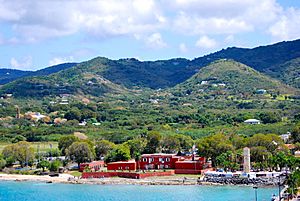
Frederiksted maintains its Victorian era architecture and original seven street by seven street city design and is host to several historic structures. Among them are St. Patrick's Catholic Church built in the 1840s and its primary school, the Customs House, the 19th Century Apothecary, and many other buildings; some which due to hurricanes past have fallen into very scenic ruins. Frederiksted operates at a more relaxed pace than most of the island, and is more lively during Carnival in January and whenever visiting cruise ships are in port.
Salt River Bay National Historical Park and Ecological Preserve contains the only known site where members of a Columbus expedition set foot on what is now United States territory. It also preserves upland watersheds, mangrove forests, and estuarine and marine environments that support threatened and endangered species. The site is marked by Fort Salé, a remaining earthworks fortification from the French period of occupation, about 1617. The park also preserves prehistoric and colonial-era archeological sites including the only existent example of a ball court in the Caribbean. This is one of two sites on the island for bioluminescent bays (the other being Altona Lagoon).
Fort Christiansværn built in 1749 and other buildings are maintained by the National Park Service as the Christiansted National Historic Site.
Buck Island Reef National Monument preserves a 176-acre (71 ha) island just north of St. Croix and the surrounding reefs. This is a popular destination for snorkelers. Buck Island maintains a U.S. Coast Guard weather station and is also home to a student monitored lemon shark breeding ground. Green Cay (pronounced green key) is a small island located southwest of Buck Island and also hosts a nearby reef popular among scuba divers and snorkelists—Tamarind Reef.
Scuba diving, snorkeling, and watersports
The island enjoys warm waters year-round (77'F-86'F) and features the watersports as a travel attraction, including: scuba diving, snorkeling, kayaking, paddleboarding, surfing, kite surfing, parasailing, jet skiing, fishing charters, and sunset sailing tours. Because of the island's underwater topography, St. Croix is known, in particular, for its scuba diving and two prominent features: Frederiksted Pier and wall diving on the drop-off (Salt River).
Frederiksted is a popular scuba destination for the pier, seahorses, reef diving, and access to wreck diving. This western side of the island is also known for having very calm waters and is ideal for snorkeling with easy access from the beach. Paddleboarding is very popular near Frederiksted here for those same calm features. The Frederiksted Pier is a world-class destination for scuba, snorkelling, and just plain jumping off to climb up and jump again. Scuba on the Frederiksted Pier is a shallow dive, ideal for trying scuba the first time course PADI Discover Scuba Diving (aka: Resort Diving), for extended shore diving, Night diving, and especially for Underwater photography—rated one of the best dives in the territory. The only dive shop in Frederiksted is N2theBlue Scuba Diving.
The north coast of the island (Salt River to Cane Bay) is the drop-off with the wall diving just outside Salt River. Just a few hundred meters off shore the topography makes a sudden drop into a deep underwater trench, featuring scenic coral reefs, abundant tropical fish, and migrant sea turtles. Kayaking is very popular from the Salt River area.
Christiansted is the largest city and is a bit east of the north drop, protected by reef, and a short distance to Buck Island and Green Cay.
Bioluminescent bays
There are two bioluminescent bays or bio bays on St Croix. The most widely known and visited is located at Salt River Bay National Historical Park and Ecological Preserve. A second bio bay can be found at Altona Lagoon. Bio bays are extremely rare with "only seven year-round lagoons known to exist in the Caribbean".
A combination of factors creates the necessary conditions for bioluminescence: red mangrove trees surround the water (the organisms have been related to mangrove forest, although mangrove is not necessarily associated with this species). A study at the bio bay located at Salt River is being conducted as of 2013 by faculty and students from the University of South Carolina, the University of North Carolina-Wilmington and the University of the Virgin Islands. Their research is focused on analyzing quality and nutrient composition of the water, the distribution of a micro-organism, the dinoflagellate Pyrodinium bahamense, which glows whenever the water is disturbed, and the abundance of “cysts,” dormant dinoflagellates embedded in the sea floor.
A concurrent complementary study is being undertaken by the St. Croix Environmental Association in conjunction with Scripps Institution of Oceanography which focuses on counting the photon density of the phenomenon over time and through various conditions of weather and other impacts. Water quality and taxonomic analysis from both studies will be shared and correlated to create one of the most thorough investigations of year-round bioluminescent bays to date.
The two bio bays on St Croix have very different characteristics. The one at Altona Lagoon is large in size but is very shallow allowing one to see the various marine life swimming and agitating the water, lighting it up. The bio bay at Salt River is smaller in size but is deeper than Altona Lagoon. Because of its depth this bay is also home to a second form of bioluminescence called Ctenophora or comb-jellies, which are not found at Altona Lagoon.
A third bioluminescent organism is also found in Salt River. A species of marine fireworm performs its brilliant green mating ritual within 57 hours after the full moon, females rising to the surface and leaving a luminescent green puddle for the males to race through, fertilizing the eggs.
National protected areas
- Buck Island Reef National Monument
- Christiansted National Historic Site
- Green Cay National Wildlife Refuge
- Salt River Bay National Historical Park and Ecological Preserve
- Sandy Point National Wildlife Refuge
- Point Udall
Images for kids
-
Dannebrog being lowered at the Governor's Mansion for the last time (31 March 1917)
-
Saint Croix geologic map, where Km is the Cretaceous Mt. Eagle Group, Kd is Cretaceous diorite, Kg is Cretaceous gabbro, Tbf is the Pliocene Blessing Formation, Tmb and Tlr are the Miocene King shall Limestone, Qab is Quaternary alluvium, and Qr is Quaternary reef.
See also
 In Spanish: Santa Cruz (Islas Vírgenes) para niños
In Spanish: Santa Cruz (Islas Vírgenes) para niños


